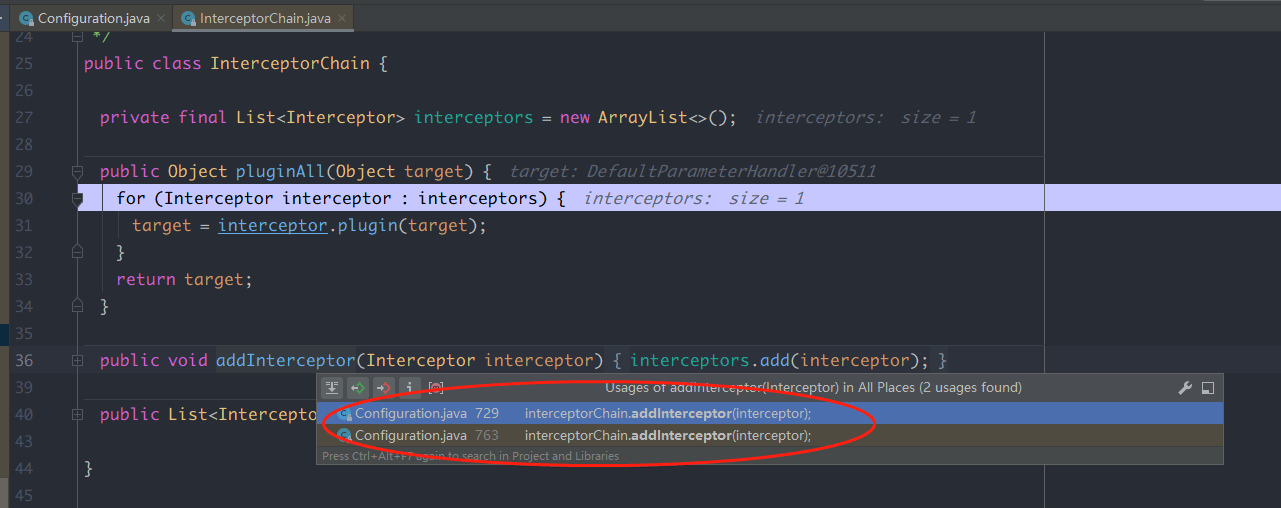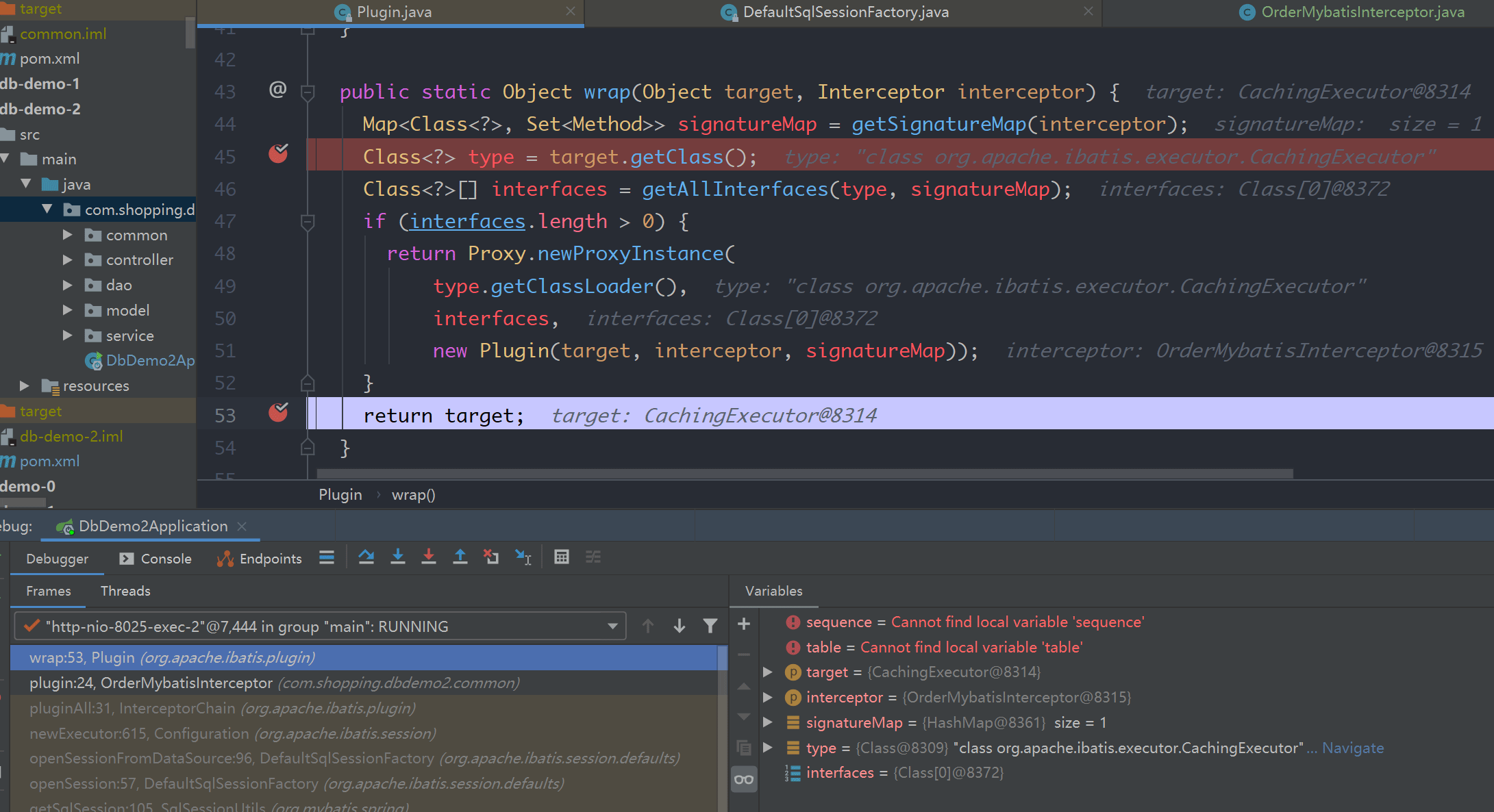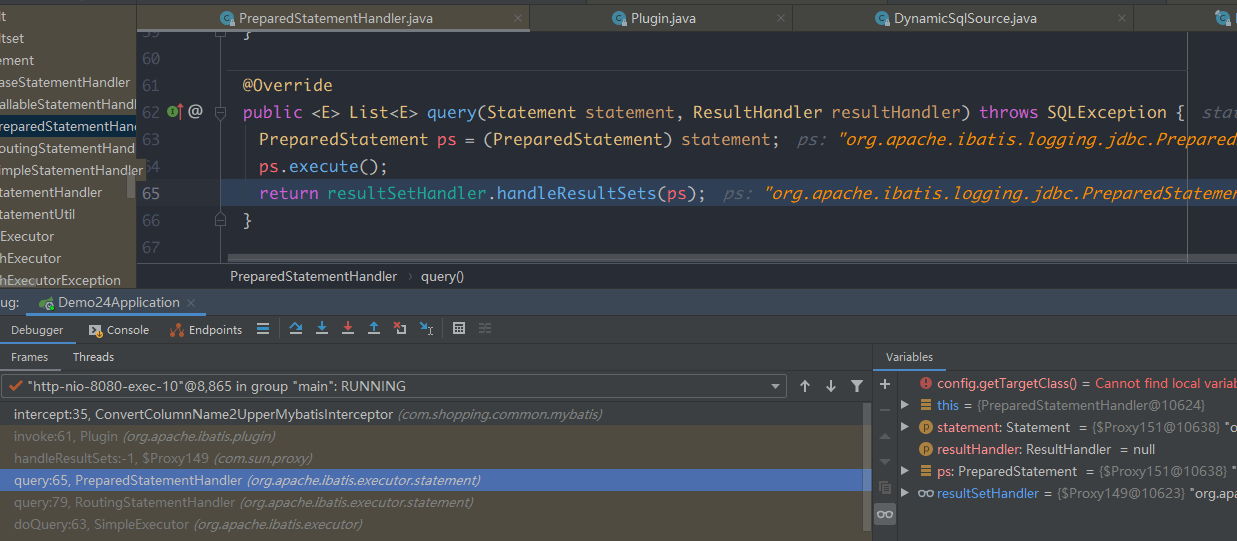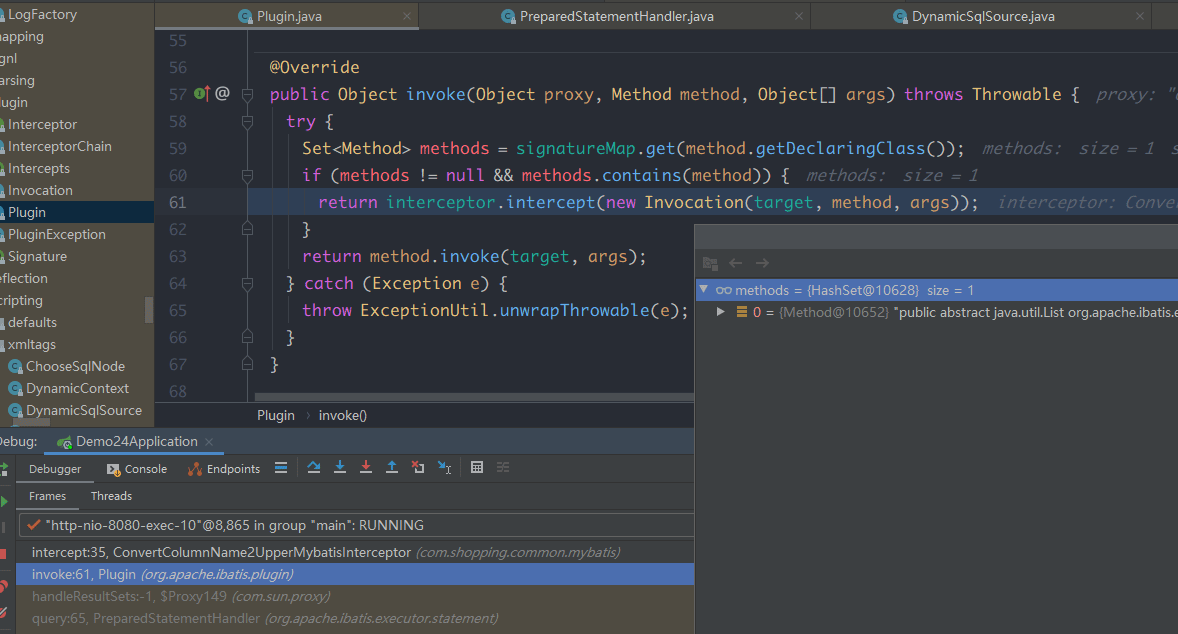您好,登錄后才能下訂單哦!
您好,登錄后才能下訂單哦!
本篇內容介紹了“MyBatis攔截器的實現原理是什么及怎么使用”的有關知識,在實際案例的操作過程中,不少人都會遇到這樣的困境,接下來就讓小編帶領大家學習一下如何處理這些情況吧!希望大家仔細閱讀,能夠學有所成!
Mybatis攔截器并不是每個對象里面的方法都可以被攔截的。Mybatis攔截器只能攔截Executor、StatementHandler、ParameterHandler、ResultSetHandler四個類里面的方法,這四個對象在創建的時候才會創建代理。
用途:實際工作中,可以使用Mybatis攔截器來做一些SQL權限校驗、數據過濾、數據加密脫敏、SQL執行時間性能監控和告警等。
以在Spring中創建 StatementHandler.update()方法的攔截器為例:
@Component
@Order(1)
@Intercepts({@Signature(type = StatementHandler.class, method = "update", args = {Statement.class}),})
public class SqlValidateMybatisInterceptor extends PRSMybatisInterceptor {
@Override
protected Object before(Invocation invocation) throws Throwable {
String sql="";
Statement statement=(Statement) invocation.getArgs()[0];
if(Proxy.isProxyClass(statement.getClass())){
MetaObject metaObject= SystemMetaObject.forObject(statement);
Object h=metaObject.getValue("h");
if(h instanceof StatementLogger){
RoutingStatementHandler rsh=(RoutingStatementHandler) invocation.getTarget();
sql=rsh.getBoundSql().getSql();
}else {
PreparedStatementLogger psl=(PreparedStatementLogger) h;
sql=psl.getPreparedStatement().toString();
}
}else{
sql=statement.toString();
}
if(containsDelete(sql)&&!containsWhere(sql)){
throw new SQLException("不能刪除整張表,sql:"+sql);
}
return null;
}
private boolean containsDelete(String sql){
return sql.contains("delete")||sql.contains("DELETE");
}
private boolean containsWhere(String sql){
return sql.contains("where")||sql.contains("WHERE");
}
}
public class PRSMybatisInterceptor implements Interceptor {
Boolean needBreak=false;
@Override
public Object intercept(Invocation invocation) throws Throwable {
Object result= before(invocation);
if(needBreak){
return result;
}
result= invocation.proceed();
result=after(result,invocation);
return result;
}
protected Object before(Invocation invocation) throws Throwable{
return null;
}
protected Object after(Object result,Invocation invocation) throws Throwable{
return result;
}
@Override
public Object plugin(Object o) {
return Plugin.wrap(o, this);
}
@Override
public void setProperties(Properties properties) {
}
}1. 自定義攔截器 實現 org.apache.ibatis.plugin.Interceptor 接口與其中的方法。在plugin方法中需要返回 return Plugin.wrap(o, this)。在intercept方法中可以實現攔截的業務邏輯,改方法的 參數 Invocation中有原始調用的 對象,方法和參數,可以對其任意處理。
2. 在自定義的攔截器上添加需要攔截的對象和方法,通過注解 org.apache.ibatis.plugin.Intercepts 添加。如示例代碼所示:
Intercepts的值是一個簽名數組,簽名中包含要攔截的 類,方法和參數。
代理對象指的是:可以被攔截的4個類的實例。
代理對象創建時需要解析攔截器,從而利用JDK動態代理將攔截器的邏輯織入原始對象。
DefaultSqlSession中依賴Executor,如果新建的時候會創建executor
private SqlSession openSessionFromConnection(ExecutorType execType, Connection connection) {
...
final Executor executor = configuration.newExecutor(tx, execType);
return new DefaultSqlSession(configuration, executor, autoCommit);
}
public Executor newExecutor(Transaction transaction, ExecutorType executorType) {
executorType = executorType == null ? defaultExecutorType : executorType;
executorType = executorType == null ? ExecutorType.SIMPLE : executorType;
Executor executor;
if (ExecutorType.BATCH == executorType) {
executor = new BatchExecutor(this, transaction);
} else if (ExecutorType.REUSE == executorType) {
executor = new ReuseExecutor(this, transaction);
} else {
executor = new SimpleExecutor(this, transaction);
}
if (cacheEnabled) {
executor = new CachingExecutor(executor);
}
executor = (Executor) interceptorChain.pluginAll(executor);
return executor;
}Executor中要用StatementHandler執行sql語句,StatementHandler是調用configuration.newStatementHandler()方法創建的。
StatementHandler handler = configuration.newStatementHandler(wrapper, ms, parameterObject, rowBounds, resultHandler, boundSql);
public StatementHandler newStatementHandler(Executor executor, MappedStatement mappedStatement, Object parameterObject, RowBounds rowBounds, ResultHandler resultHandler, BoundSql boundSql) {
StatementHandler statementHandler = new RoutingStatementHandler(executor, mappedStatement, parameterObject, rowBounds, resultHandler, boundSql);
statementHandler = (StatementHandler) interceptorChain.pluginAll(statementHandler);
return statementHandler;
}StatementHandler依賴 parameterHandler 和 resultSetHandler,在構造 StatementHandler 時會調用一下方法創建這兩個 handler。
this.parameterHandler = configuration.newParameterHandler(mappedStatement, parameterObject, boundSql);
public ParameterHandler newParameterHandler(MappedStatement mappedStatement, Object parameterObject, BoundSql boundSql) {
ParameterHandler parameterHandler = mappedStatement.getLang().createParameterHandler(mappedStatement, parameterObject, boundSql);
parameterHandler = (ParameterHandler) interceptorChain.pluginAll(parameterHandler);
return parameterHandler;
}this.resultSetHandler = configuration.newResultSetHandler(executor, mappedStatement, rowBounds, parameterHandler, resultHandler, boundSql);
public ResultSetHandler newResultSetHandler(Executor executor, MappedStatement mappedStatement, RowBounds rowBounds, ParameterHandler parameterHandler,
ResultHandler resultHandler, BoundSql boundSql) {
ResultSetHandler resultSetHandler = new DefaultResultSetHandler(executor, mappedStatement, parameterHandler, resultHandler, boundSql, rowBounds);
resultSetHandler = (ResultSetHandler) interceptorChain.pluginAll(resultSetHandler);
return resultSetHandler;
}從對象的創建過程中可以看出 代理 對象的創建時通過 InterceptorChain.pluginAll() 方法創建的。

查看 攔截器鏈 InterceptorChain 發現,其中的攔截器的添加是在 Configuration 中。因為攔截器被聲明為Bean了,所以在MyBatis初始化的時候,會掃描所有攔截器,添加到 InterceptorChain 中。
從上一步得知代理對象的創建是調用 Interceptor.pugin() 方法,然后調用 Plugin.wrap() 方法
Interceptor
@Override
public Object plugin(Object o) {
return Plugin.wrap(o, this);
}Plugin實現了 InvocationHandler 接口

在 Plugin.wrap() 方法中會獲取當前攔截器的接口,生成動態代理。

在動態代理中當代理對象調用方法時,會將方法的調用委托給 InvocationHandler,也就是 Plugin,
如下圖所示;

在該方法中 獲取攔截器簽名中的方法,如果包含當前方法,則調用攔截方法,否則執行原方法的調用。
攔截器的順序配置使用 Spring 中的 org.springframework.core.annotation.Order 注解配置。
order值大的攔截器先執行,order值大的在interceptors中越靠后,最后生成代理,所以先執行。


“MyBatis攔截器的實現原理是什么及怎么使用”的內容就介紹到這里了,感謝大家的閱讀。如果想了解更多行業相關的知識可以關注億速云網站,小編將為大家輸出更多高質量的實用文章!
免責聲明:本站發布的內容(圖片、視頻和文字)以原創、轉載和分享為主,文章觀點不代表本網站立場,如果涉及侵權請聯系站長郵箱:is@yisu.com進行舉報,并提供相關證據,一經查實,將立刻刪除涉嫌侵權內容。